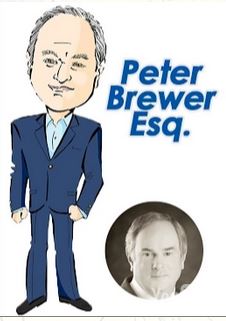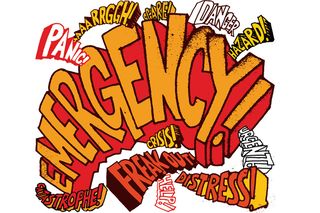
I think this is the first time I've ever done this on the blog, but immediately following LegalTech, I had to leave for a trip. However, Peter Brewer, my trusty colleague from the Law Practice Management & Technology Section, was kind enough to write up a guest-post about his experience this year.
<<< I leave it to you to determine which image to my left is the real Peter Brewer:
"The ALM LegalTech West Coast event, historically always venued in the Los Angeles area, was held instead this year in San Francisco at the Hyatt Regency on July 13 and 14. As in the past, the event consisted of keynote sessions, seminars, and importantly, a large vendor exhibit area. The first day had five seminar tracks running consisting of; corporate legal operations, information governance, advanced IT, the cloud and mobile technology, and E discovery. The second day the tracks were four in number and consisted of; information governance, E discovery, information technology, and corporate counsel perspectives.
I attended only the second day, which kicked off with an interesting discussion of the Ellen Pao versus Kleiner Perkins Caufield Byers case. On the panel were two reporters who covered the trial, and the defense attorney, Lynne C. Hermle, from Orrick Herrington and Sutcliffe. The plaintiff’s attorney, Alan B. Exelrod, of Rudy, Exelrod, Zieff & Lowe, had been scheduled to be on the panel but had to withdraw due to a scheduling conflict. This keynote proved to be a lively hour of informal discussion in which Lynne Hermle gave substantial credit to the jury for their thorough and diligent evaluation of the evidence.
The keynote was followed by seminar sessions throughout the day, with ample breaks to visit the vendor exhibit hall. I attended one of the seminar sessions on E discovery, “Every day E discovery: Bringing It In-House or Outsourcing It.” The panelists were knowledgeable; they consisted of an independent consultant, a claims manager, a partner from the major law firm, and a representative of Lexis-Nexis. The discussion was lively, but for my tastes it was a broad overview with much discussion of the concepts but very little grass-roots, take-home practical advice. I came away feeling that the discussion had been thoughtful, but with no better sense of, “where do I start,” or “what are my first steps when I get back to the office.”
I also attended a session on cyber security. Again, the panelists were well qualified and knowledgeable. The discussion included such things as the availability of data breach insurance, engaging outside consultants to do cyber security audits of your business, and a general, high-level discussion of the topic of data security in the office. Toward the end of the session the moderator opened the discussion up to questions from the audience. I commented to the panel that, while I found the discussion interesting, I would like to have some specific action items that I could take back to my five-attorney law firm and implement, step-by-step.
The advice that was given in response was to start with written policies and procedures. As in any endeavor, if you don’t know where you’re going, any road will take you there. A cautionary bit of advice that went with the suggestion of developing written policies and procedures was that then you are duty bound to follow them. Failing to observe your own procedures can increase rather than decrease your liability.
It was also suggested that I consider hiring a security consultant to do a risk assessment of my office. Apparently for a firm the size of mine (<10 total staff) this endeavor can run approximately $5,000 – $10,000. While this seems like a sizable chunk of discretionary spending, the cost of a data breach and one’s exposure to liability for it would no doubt be a multiple of many times that amount.
Contrasting the 2015 event with LegalTech events in years past, one significant difference stood out to me. In past years there were seminar sessions on a broader variety of topics. There have been sessions on such things as what financial reports a law firm owner should regularly produce and review, sessions on tech gadgets, useful mobile devices, helpful apps, practice management software, and so forth. This year by far the greatest emphasis was on data. Even the vendor exhibit hall, although it did have exhibitors of a variety of useful products, seemed to be heavy on the e discovery and data security vendors. While this information is no doubt useful to some, I found it not very applicable to my small firm’s real estate law practice, where we do not get cases involving discovery of tens of thousands, or more, documents. Circling back to the keynote discussion that kicked off that day, attorney Lynne Hermle said that in the Ellen Pao vs. Kleiner Perkins case Ellen Pao had produced something approaching a million documents. May I be blessed to reach the end of my career without ever having to tackle such a daunting task.
All in all, the LegalTech event is an enjoyable break from the office, especially for those of us interested in tech. Are you one of us? Check your wrist. If there’s an Apple watch on it, you are inescapably a techie. It was nice to have this event in Northern California for a change, and the Hyatt Regency was a lovely and accommodating venue. I hope to see the event back in San Francisco again next year."
Peter Brewer
************************************************
About the Author: Peter N. Brewer has been a lawyer for over 35 years, and is also licensed by the California Bureau of Real Estate as a real estate broker. Peter started his own firm in 1995. The firm has grown to five attorneys, practicing real estate and lending law. The firm serves the legal needs of homeowners, purchasers and sellers, real estate and mortgage brokers, agents, brokerages, title companies, investors, other real estate professionals and their clients. Peter and his firm also represent clients in debt collection, creditor representation in bankruptcy, breach of contract matters, and other litigation and transactional work.
Peter obtained his Juris Doctor degree from the University of Santa Clara Law School in 1979 and is also licensed to practice law in all State and Federal Courts in Idaho and certain Federal Courts in Michigan and Iowa (and probably in other states he no longer recalls). He loves dogs, hates kids, and is generally considered to have an insufferable disposition.
Law Offices of Peter N. Brewer
2501 Park Blvd, 2nd Flr.
Palo Alto, CA 94306
(650) 327-2900 x 12
www.BrewerFirm.com
BayAreaRealEstateLawyers.com
Real Estate Law – From the Ground Up®
 Disclaimer: This is a State Bar of California Opinion, and I’m Vice-Chair of the Council of California State Bar Sections (CSBS). I want to remind you, “This blog site is published by and reflects the personal views of Perry L. Segal, in his individual capacity. Any views expressed herein have not been adopted by the State Bar of California’s Board of Trustees or overall membership, nor are they to be construed as representing the position of the State Bar of California.”
Disclaimer: This is a State Bar of California Opinion, and I’m Vice-Chair of the Council of California State Bar Sections (CSBS). I want to remind you, “This blog site is published by and reflects the personal views of Perry L. Segal, in his individual capacity. Any views expressed herein have not been adopted by the State Bar of California’s Board of Trustees or overall membership, nor are they to be construed as representing the position of the State Bar of California.”










